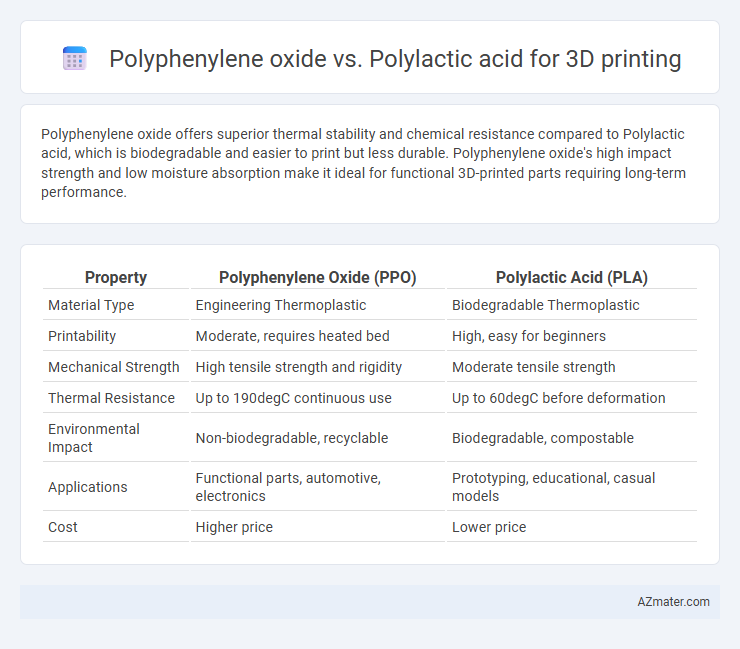Polyphenylene oxide offers superior thermal stability and chemical resistance compared to Polylactic acid, which is biodegradable and easier to print but less durable. Polyphenylene oxide's high impact strength and low moisture absorption make it ideal for functional 3D-printed parts requiring long-term performance.
Table of Comparison
| Property | Polyphenylene Oxide (PPO) | Polylactic Acid (PLA) |
|---|---|---|
| Material Type | Engineering Thermoplastic | Biodegradable Thermoplastic |
| Printability | Moderate, requires heated bed | High, easy for beginners |
| Mechanical Strength | High tensile strength and rigidity | Moderate tensile strength |
| Thermal Resistance | Up to 190degC continuous use | Up to 60degC before deformation |
| Environmental Impact | Non-biodegradable, recyclable | Biodegradable, compostable |
| Applications | Functional parts, automotive, electronics | Prototyping, educational, casual models |
| Cost | Higher price | Lower price |
Introduction to Polyphenylene Oxide (PPO) and Polylactic Acid (PLA)
Polyphenylene oxide (PPO) is a high-performance thermoplastic known for its excellent thermal stability, chemical resistance, and dimensional accuracy, making it suitable for advanced 3D printing applications requiring durability and precision. Polylactic acid (PLA) is a biodegradable thermoplastic derived from renewable resources like corn starch, widely favored in 3D printing for its ease of use, low warping, and eco-friendly properties. The distinct material characteristics of PPO and PLA influence the selection process based on application needs, such as mechanical strength versus environmental impact.
Material Composition and Chemical Structure
Polyphenylene oxide (PPO) is a high-performance thermoplastic with an aromatic backbone, offering excellent thermal stability and chemical resistance, making it ideal for demanding 3D printing applications. Polylactic acid (PLA) is a biodegradable aliphatic polyester derived from renewable resources with a linear structure, known for its ease of printing and environmental friendliness but limited heat resistance. The aromatic ether linkages in PPO contribute to its robustness, while the ester linkages in PLA result in biodegradability but lower mechanical strength and thermal stability.
Mechanical Properties Comparison
Polyphenylene oxide (PPO) exhibits superior impact resistance and dimensional stability compared to polylactic acid (PLA), making it ideal for functional 3D printed parts requiring durability. PLA offers higher tensile strength but is more brittle and prone to deformation under heat, limiting its use in mechanically demanding applications. The flexibility and chemical resistance of PPO outperform PLA's rigidity, providing better longevity in demanding environmental conditions for 3D printed components.
Thermal Stability and Printability
Polyphenylene oxide (PPO) offers superior thermal stability with a high glass transition temperature around 210degC, making it ideal for applications requiring resistance to heat deformation during 3D printing. Polylactic acid (PLA), with a lower melting point near 180degC, is easier to print but less thermally stable and prone to warping under prolonged heat exposure. PPO's excellent dimensional stability and chemical resistance enhance print quality in high-temperature environments, whereas PLA's biodegradability and ease of use make it favored for prototypes and less heat-demanding parts.
Biodegradability and Environmental Impact
Polylactic acid (PLA) is a biodegradable thermoplastic derived from renewable resources like corn starch, making it environmentally friendly and suitable for sustainable 3D printing applications. In contrast, polyphenylene oxide (PPO) is a durable, non-biodegradable polymer with higher heat resistance but poses environmental concerns due to its petroleum-based origin and lack of compostability. Choosing PLA over PPO significantly reduces plastic waste and carbon footprint, aligning with eco-conscious manufacturing and biodegradable product requirements.
Surface Finish and Post-Processing Differences
Polyphenylene oxide (PPO) offers a smoother surface finish with minimal layer lines due to its high thermal stability and excellent flow characteristics, making it ideal for applications requiring fine detail and glossy appearance. Polylactic acid (PLA), while easier to print with, tends to show more visible layer lines and requires more intensive post-processing such as sanding and coating to achieve a similar smoothness. PPO's superior chemical resistance also allows for aggressive post-processing methods like vapor smoothing or solvent polishing without degrading the part, unlike PLA which is more sensitive to heat and solvents.
Cost Analysis and Market Availability
Polyphenylene oxide (PPO) filaments for 3D printing are generally more expensive due to their higher manufacturing costs and specialized applications, whereas polylactic acid (PLA) remains the most cost-effective and widely available option for both hobbyists and professionals. PLA's extensive market presence and biodegradability contribute to its affordability and accessibility, with numerous suppliers offering various formulations at competitive prices. PPO, while offering superior thermal and mechanical properties, has limited market availability and niche demand, resulting in higher prices and less variety compared to PLA.
Applications in 3D Printing Industry
Polyphenylene oxide (PPO) in 3D printing offers excellent thermal stability and mechanical strength, making it ideal for functional prototypes, automotive parts, and electrical components requiring durability and heat resistance. Polylactic acid (PLA) excels in producing biodegradable, environmentally friendly models, widely used for educational tools, packaging prototypes, and cosmetic items with low thermal and mechanical demands. The choice between PPO and PLA in the 3D printing industry depends heavily on application-specific requirements for strength, heat resistance, and sustainability.
Challenges and Limitations of PPO and PLA
Polyphenylene oxide (PPO) presents challenges in 3D printing due to its high melting temperature and poor adhesion between layers, which can result in warping and dimensional inaccuracies. Polylactic acid (PLA), while easier to print with, suffers from low thermal resistance and brittleness, limiting its use in high-stress or high-temperature applications. Both materials require careful calibration of printer settings and environmental controls to mitigate issues like moisture sensitivity in PLA and viscous flow difficulties in PPO.
Choosing the Right Material for Your 3D Printing Needs
Polyphenylene oxide (PPO) offers high thermal stability, excellent dimensional accuracy, and superior chemical resistance, making it ideal for industrial 3D printing applications requiring durability and precision. Polylactic acid (PLA), made from renewable resources, provides ease of printing, biodegradability, and a smooth surface finish, suited for prototypes, educational models, and eco-friendly projects. Selecting between PPO and PLA depends on the specific needs of your project, such as mechanical properties, environmental impact, and printing conditions.

Infographic: Polyphenylene oxide vs Polylactic acid for 3D printing
 azmater.com
azmater.com